FAQ - Advanced Bathroom Queries
Do Different Toilets Flush Better

Do some toilets have a superior flush performance?
In this article, we delve into the science behind toilet flushing, exploring the factors that affect performance.
From the shape of the toilet bowl to the flush mechanism and water pressure, we analyze the intricate details that determine how well a toilet flushes.
We also compare the effectiveness of single flush versus dual flush toilets and examine the role of trapway size and rim jets.

Join us on this journey of toilet mastery as we uncover the secrets to a better flush.
Key Takeaways
- The flush mechanism, including the design of the toilet bowl, trapway size, and flushing mechanism, plays a crucial role in toilet flushing performance.
- Different flush mechanisms, such as flapper, siphon, pressure-assisted, and dual-flush toilets, offer varying levels of flushing power and water-saving capabilities.
- Dual-flush toilets are advantageous as they provide two separate flushing options, saving water, reducing water consumption, and lowering utility bills.
- Advanced flushing technologies, such as dual-flush systems, pressure-assist flushing, sensor-based flushing, and water-saving technologies, contribute to water conservation and help achieve sustainability goals.
The Science Behind Toilet Flushing
To understand the science behind toilet flushing, we need to examine the mechanics of how water and waste are efficiently removed from the bowl. Toilet flushing mechanisms play a crucial role in this process. When the flush lever is activated, it lifts a flapper valve or a flush valve, allowing water to rush into the bowl. The force of the water creates a siphoning effect, pulling both water and waste down the drain.
The design of the toilet bowl and the impact of water volume also contribute to effective flushing. The shape of the bowl, particularly the trapway and the contour of the bowl itself, helps to create the necessary flow and pressure. Additionally, the amount of water used during each flush affects the flushing power.
Understanding the impact of water volume and the mechanics of toilet flushing is essential in evaluating the performance of different toilet models. Now, let’s delve into the importance of understanding toilet bowl shape.
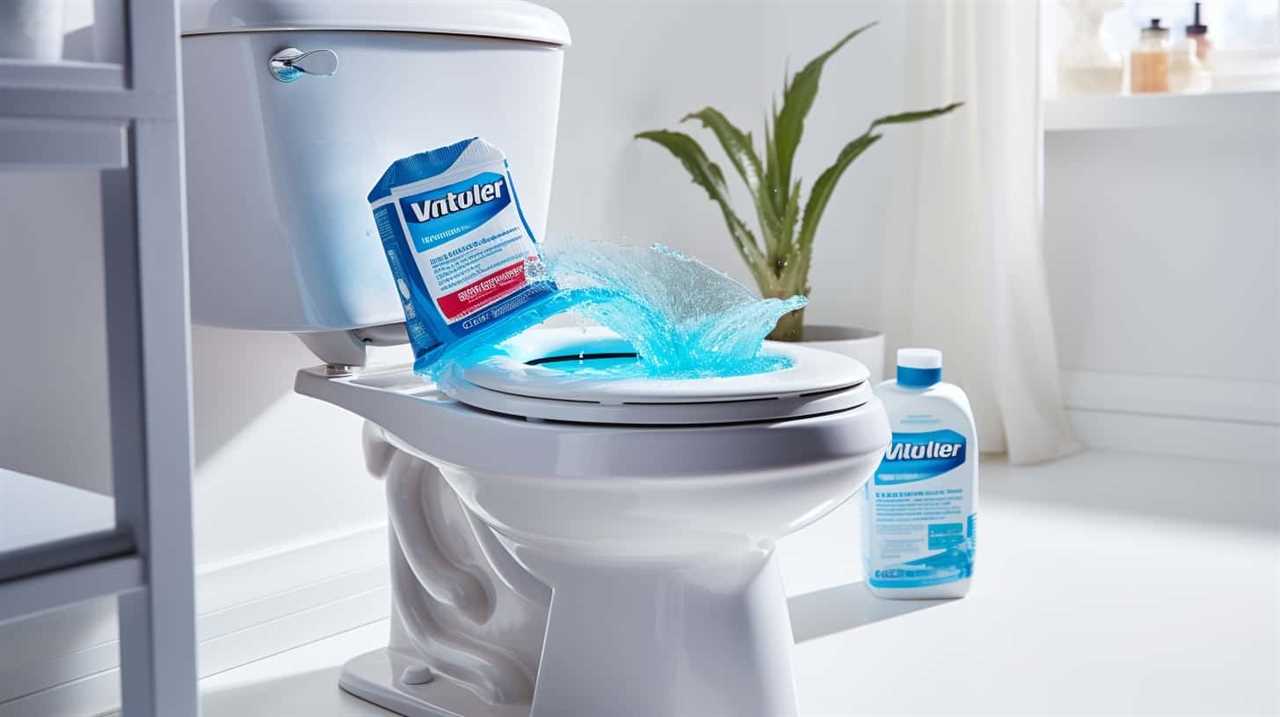
Understanding Toilet Bowl Shape
When it comes to understanding toilet bowl shape, it’s essential to consider the impact it has on flushing efficiency.
The shape of the bowl can greatly affect how effectively waste is removed during the flushing process.
Impact of Shape
Our research has shown that certain toilet bowl shapes, particularly those with a wider and deeper design, tend to provide a more effective flush. The shape of a toilet bowl plays a crucial role in the overall flushing power of the toilet.
A wider and deeper bowl allows for a larger volume of water to enter the bowl during the flush, creating a stronger force to push waste down the drain. This enhanced flushing power is especially beneficial when dealing with solid waste or larger amounts of toilet paper.
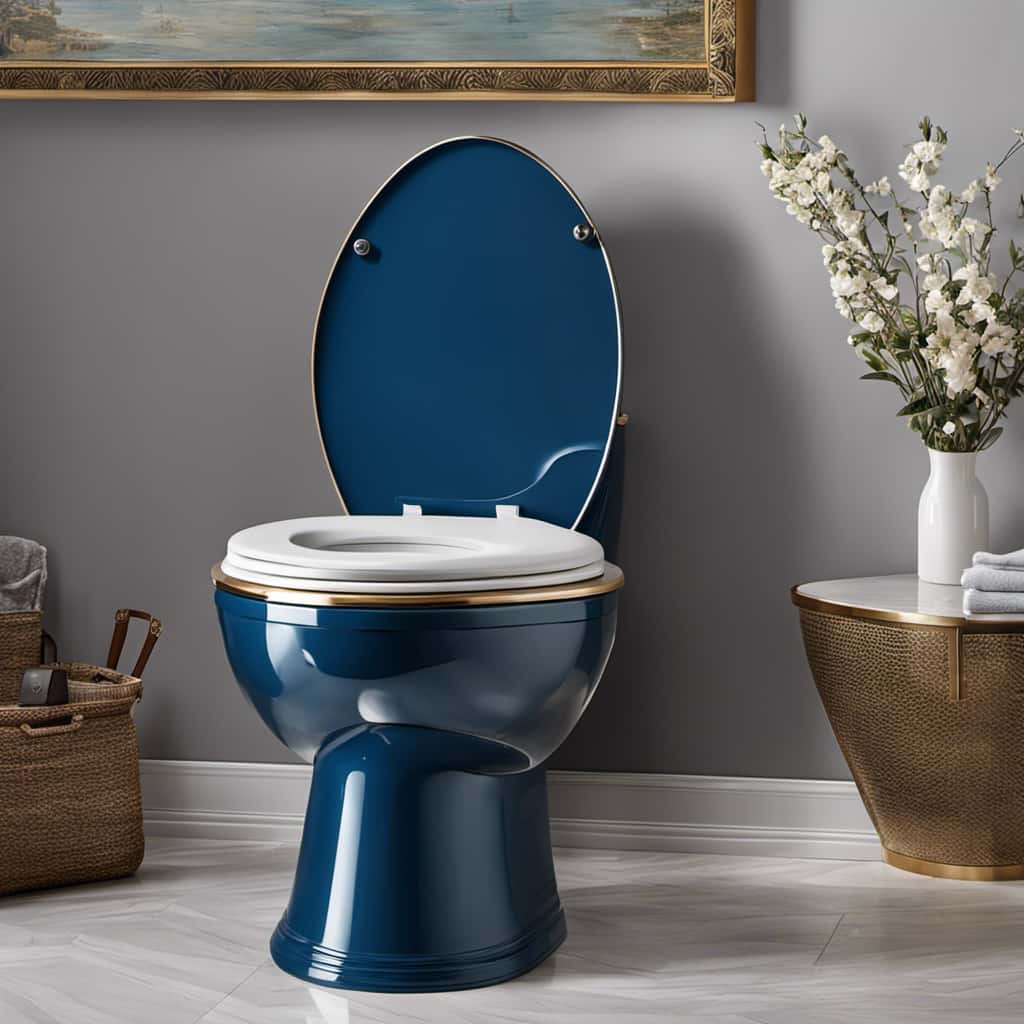
Additionally, the wider design of the bowl helps prevent clogging by allowing waste to move more freely through the drain.
Therefore, when considering toilet design, it’s important to take into account the impact of shape on flushing efficiency.
Flushing Efficiency Comparison
From our research on the impact of shape, we can clearly see that certain toilet bowl designs, particularly those with a wider and deeper shape, provide a more effective flush. However, flushing efficiency isn’t solely determined by the shape of the bowl. Other factors, such as the efficiency of the flapper and siphon, as well as the water pressure, also play a significant role.
Here are three key points to consider:
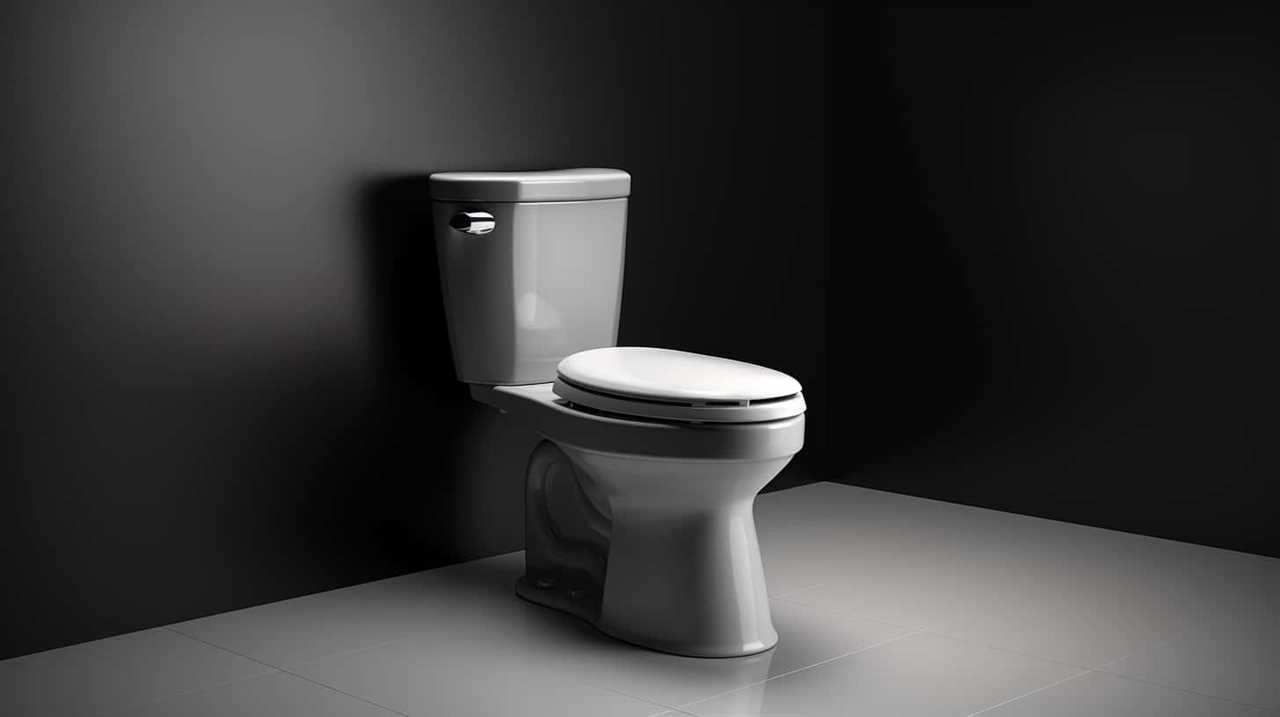
- Flapper efficiency: The flapper is responsible for controlling the flow of water from the tank into the bowl during a flush. A well-designed flapper ensures a quick and powerful flush, minimizing the risk of clogs and inefficient waste removal.
- Siphon efficiency: The siphon mechanism helps create a strong suction force that propels waste down the drain. An efficient siphon system maximizes the flushing power, ensuring thorough waste removal with minimal water usage.
- Impact of water pressure: Higher water pressure can enhance flushing efficiency by providing a stronger force to push waste through the drain. However, excessively high pressure can lead to excessive water consumption, while low pressure may result in incomplete waste removal.
Understanding these factors is crucial for achieving optimal flushing efficiency in toilets. By considering the shape, flapper and siphon efficiency, and water pressure, you can make an informed decision when selecting a toilet that meets your needs for a powerful and efficient flush.
Exploring Different Flush Mechanisms
When it comes to toilet flush mechanisms, there are several options to consider.
One common mechanism is the flapper, which is a rubber valve that releases water from the tank into the bowl.
Another option is the siphon, which uses a combination of gravity and pressure to create a powerful flush.

Additionally, there are toilets with pressure-assisted flush mechanisms, which use compressed air to force water into the bowl.
Lastly, dual-flush toilets offer the advantage of being able to choose between a lower volume flush for liquid waste and a higher volume flush for solid waste.
Flapper Vs. Siphon
In comparing different flush mechanisms, we’ll delve into the effectiveness of flapper versus siphon systems.
When it comes to flapper types, there are various options available, each designed to optimize water usage and enhance flushing efficiency. From the traditional flapper to the dual-flush and adjustable flapper, consumers have the opportunity to choose a style that suits their specific needs.

On the other hand, siphon systems excel in terms of efficiency, as they utilize the force of gravity and water pressure to create a powerful flush. Their design allows for a quick and thorough evacuation of waste, minimizing the chances of clogs and improving overall performance.
Gravity Vs. Pressure-Assisted
Now let’s delve further into the comparison between gravity and pressure-assisted flush mechanisms, exploring their different capabilities in terms of efficiency and flushing power.
Gravity flush toilets operate by using the force of gravity to empty the contents of the bowl. These toilets rely on the weight and volume of water to create enough force to flush waste away.
On the other hand, pressure-assisted flush toilets utilize a combination of water and air pressure to create a more powerful flushing action. This mechanism forces water into the bowl with greater force, resulting in a more efficient removal of waste.
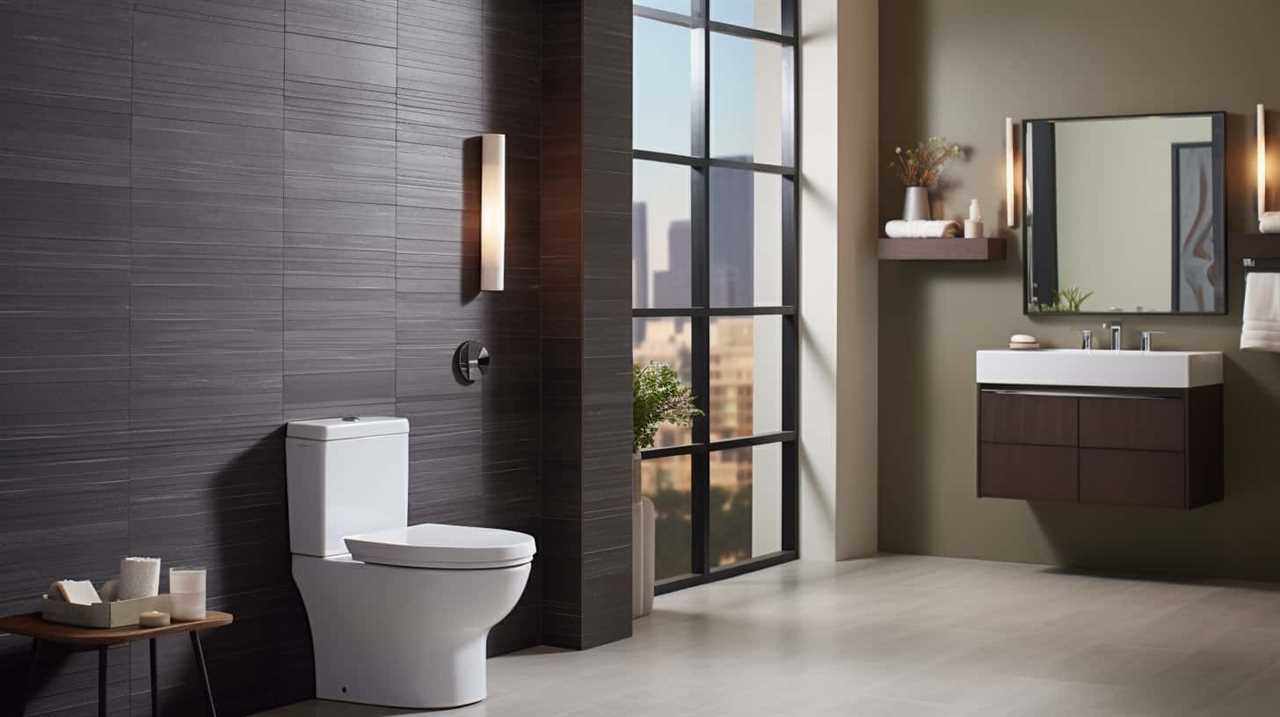
When it comes to toilet bowl materials, both gravity and pressure-assisted toilets can accommodate a variety of options such as porcelain, ceramic, or even plastic.
Similarly, the design of the toilet seat can vary for both types of flush mechanisms, ensuring comfort and functionality for users.
Dual-Flush Advantages
Let’s continue our exploration of different flush mechanisms by delving into the advantages of dual-flush toilets. These innovative fixtures offer significant water-saving benefits and contribute to a more sustainable environment. Here are three reasons why dual-flush toilets are a smart choice:
- Water Saving: Dual-flush toilets are designed with two separate flushing options – a smaller flush for liquid waste and a larger flush for solid waste. By giving users the ability to choose the appropriate flush, these toilets can save a substantial amount of water compared to traditional toilets. This not only reduces water consumption but also lowers utility bills.
- Environmental Benefits: With their water-saving capabilities, dual-flush toilets play a crucial role in conserving water resources. By using less water per flush, these toilets contribute to the sustainability of our planet by reducing the strain on freshwater sources. This makes them an environmentally responsible choice for any household or commercial setting.
- Cost-Effectiveness: While the upfront cost of a dual-flush toilet may be slightly higher than a traditional toilet, the long-term savings in water bills make it a cost-effective investment. Additionally, many regions offer incentives and rebates for installing water-saving fixtures, further offsetting the initial cost.
The Impact of Water Pressure on Flushing
Our study revealed that different toilets exhibit varying levels of flushing effectiveness due to differences in water pressure. Water pressure plays a crucial role in the flushing process, as it determines the force with which water is delivered to the bowl. Higher water pressure typically results in a more powerful flush, effectively removing waste and preventing clogs.

Additionally, toilets with water-saving flush mechanisms may require higher water pressure to achieve the same level of flushing efficiency as toilets without such mechanisms. The impact of water pressure on flushing efficiency is further influenced by toilet design, including factors such as trapway size and bowl shape.
Understanding the impact of water pressure on flushing can help consumers make informed decisions when selecting a toilet that meets their specific needs and preferences.
Factors Affecting Toilet Performance
Water pressure is one of the key factors that impact toilet performance due to its influence on flushing effectiveness. However, other important factors also play a role in determining how well a toilet performs. These factors include:
- Toilet bowl material: The material used to construct the toilet bowl can affect its performance. For example, toilets made from glazed ceramic tend to have a smoother surface, which can help prevent waste from sticking to the bowl and improve flushing efficiency.
- Toilet bowl size: The size of the toilet bowl can also impact its performance. A larger bowl may be able to accommodate more waste and provide a more effective flush, while a smaller bowl may struggle to handle larger volumes of waste.
- Flushing mechanism: The flushing mechanism of a toilet, such as gravity-fed or pressure-assisted, can greatly affect its performance. Different mechanisms have different flushing capabilities, so it’s important to choose one that suits your needs and preferences.
Understanding these factors can help you make an informed decision when selecting a toilet that meets your performance requirements.

Comparing Single Flush Vs. Dual Flush Toilets
How do single flush and dual flush toilets compare in terms of performance?
Single flush toilets have been in use for many years and are the traditional option. They use a fixed amount of water per flush, typically around 1.6 gallons.
On the other hand, dual flush toilets are a more recent innovation in toilet design evolution. They offer users the choice between a full flush and a partial flush, depending on the waste being disposed of. The full flush uses more water, around 1.6 gallons, while the partial flush uses significantly less, around 0.8 gallons.
In terms of performance, dual flush toilets are more efficient in terms of water usage, reducing the environmental impact. They provide the flexibility to conserve water when possible, making them a popular choice for those who desire mastery over their toilet’s performance.

The Role of Toilet Trapway Size
As we delve into the role of toilet trapway size, it’s important to consider the impact it has on the overall flushing performance of different toilets. The toilet trapway, also known as the waste passage, is the channel through which waste is carried away during a flush.
Here are three key points to understand the significance of toilet trapway design in optimizing flush power:
- Efficient waste removal: A wider trapway allows for better waste clearance, reducing the chance of clogs and ensuring a more effective flush.
- Enhanced water flow: A larger trapway facilitates faster water flow, creating a stronger suction force that aids in waste removal and prevents residue buildup.
- Reduced maintenance: With an adequately sized trapway, the risk of blockages and the need for frequent plunging or snaking is minimized, resulting in less maintenance and a more reliable toilet system.
Examining Toilet Bowl Rim Jets
Now that we’ve explored the role of toilet trapway size in optimizing flush power, let’s continue our discussion by examining the effectiveness of toilet bowl rim jets in enhancing flushing performance.
Toilet bowl rim jets are small holes located around the rim of the toilet bowl that release water during the flushing process. These jets play a crucial role in ensuring efficient flushing and maintaining a clean toilet bowl.
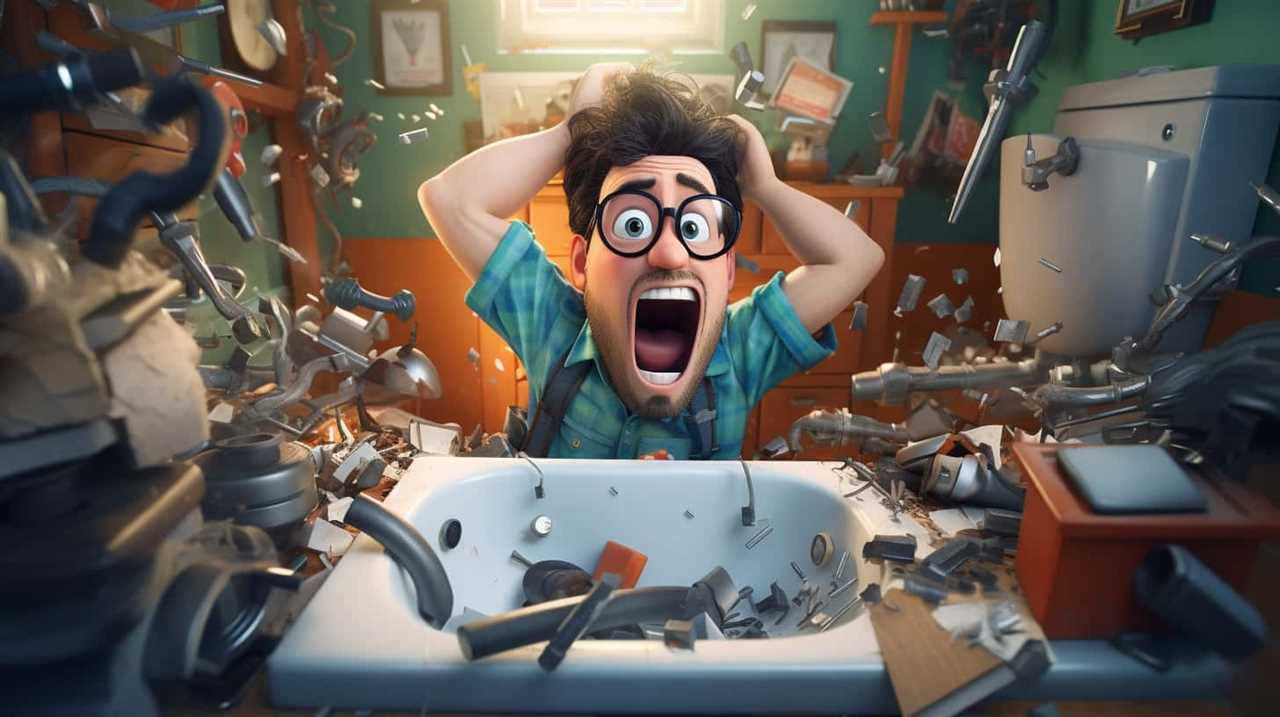
The primary function of the rim jets is to create a swirling motion in the water, which helps to effectively remove waste and prevent it from sticking to the bowl. This swirling action also aids in distributing cleaning agents evenly throughout the bowl, further enhancing the toilet bowl cleaning process.
In addition to improving toilet bowl cleaning, rim jets also contribute to water conservation. By directing the water flow towards the sides of the bowl, they help to reduce water splashing and ensure that the water is used more efficiently.
Innovative Technologies for Improved Flushing
Toilets with advanced flushing technologies offer significant improvements in performance and efficiency. These innovative technologies not only provide a more powerful and effective flush, but also contribute to water conservation efforts.
Here are three remarkable advancements in smart toilets and water-saving technologies:

- Dual-flush systems: These toilets feature two flush options – a partial flush for liquid waste and a full flush for solid waste. By giving users the choice, dual-flush toilets can save a substantial amount of water compared to traditional single-flush toilets.
- Pressure-assist flushing: This technology uses compressed air to enhance the flushing power, resulting in a more forceful and efficient flush. It effectively clears the bowl with less water, reducing water consumption without compromising performance.
- Sensor-based flushing: Smart toilets equipped with sensors detect when the user has finished and automatically initiate the flushing process. This eliminates the need for manual flushing and ensures that water is only used when necessary, further reducing water waste.
Frequently Asked Questions
How Often Should I Clean My Toilet to Maintain Optimal Flushing Performance?
To maintain optimal flushing performance, we clean our toilet regularly. The frequency of toilet cleaning depends on usage and personal preference. Regular maintenance ensures efficient flushing and prevents clogs, odors, and bacteria buildup.
Can Using Certain Types of Toilet Paper Affect the Flushing Power of a Toilet?
Using low-quality toilet paper can impact the flushing power of a toilet. The thickness and texture of the paper can clog the pipes, reducing water flow and compromising the efficiency of the flush.
Are There Any Specific Maintenance Tips or Tricks to Improve the Flushing Efficiency of Older Toilets?
Maintenance tips and troubleshooting techniques are essential for improving the flushing efficiency of older toilets. By implementing regular cleaning, checking water levels, adjusting the flapper, and ensuring proper water flow, we can optimize the performance of these toilets.
Does the Positioning of the Toilet in a Bathroom Affect Its Flushing Capabilities?
The positioning of the toilet in a bathroom can have an impact on its flushing capabilities. The flow of water and the pressure it exerts can be affected, potentially affecting the flushing power.
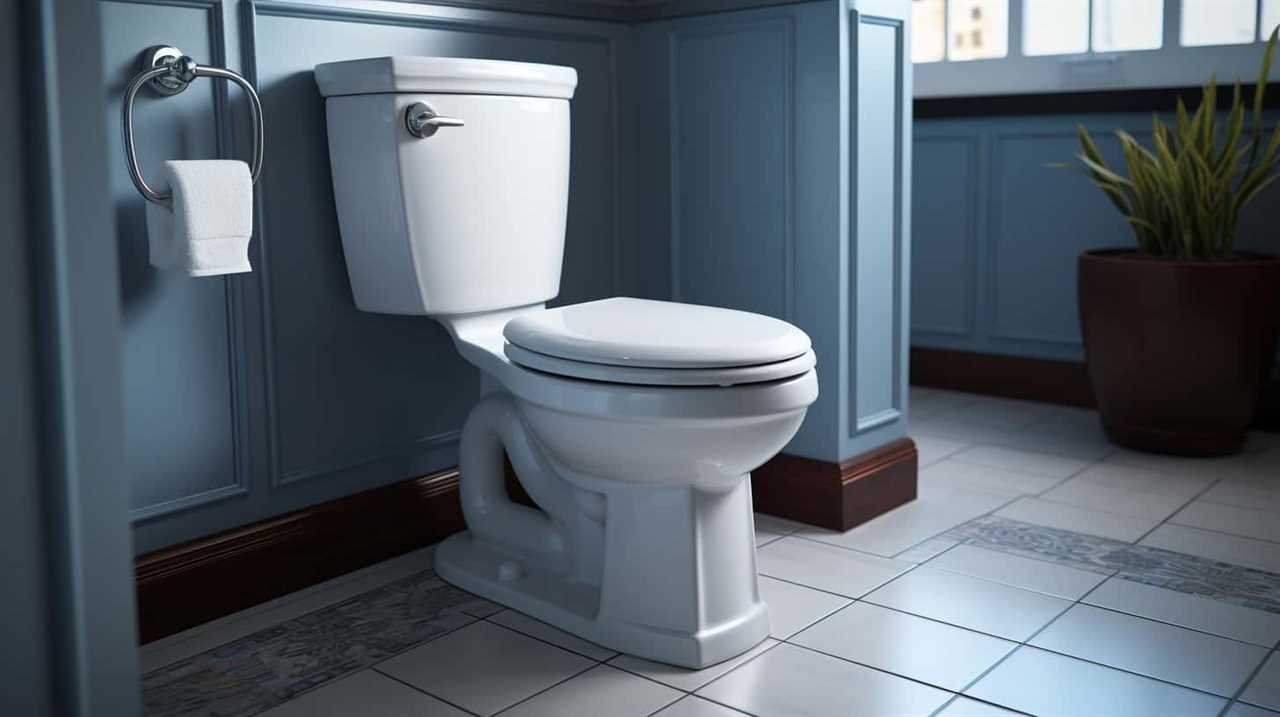
Are There Any Specific Regulations or Standards That Manufacturers Must Follow to Ensure Proper Flushing Performance in Their Toilets?
Toilet flushing regulations dictate the responsibilities of manufacturers to ensure proper flushing performance. These standards ensure that toilets meet specific criteria for efficiency and effectiveness, providing users with a reliable and satisfactory flushing experience.
Conclusion
In conclusion, understanding the science behind toilet flushing is crucial in determining which toilets perform better. Factors such as toilet bowl shape, flush mechanisms, water pressure, trapway size, and rim jets all play a role in the overall flushing performance.
By comparing single flush and dual flush toilets, we can make more informed decisions about which option is best for us.
With innovative technologies constantly improving flushing efficiency, we can confidently say that ‘knowledge is power’ when it comes to choosing the right toilet for our needs.
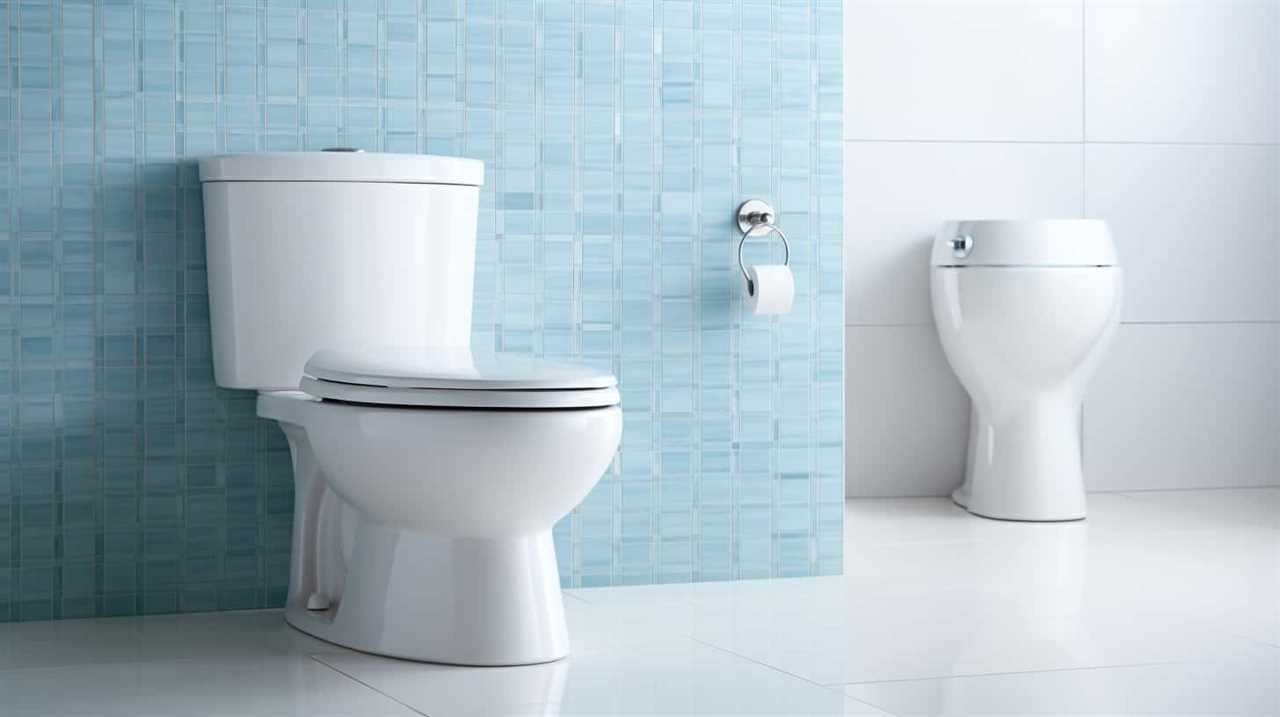
With an impeccable eye for detail and a passion for bathroom-related, Ava leads our editorial team gracefully and precisely.
Under her guidance, Best Modern Toilet has flourished as the go-to resource for modern bathroom enthusiasts. In her free time, you might find Ava exploring antique shops and looking for vintage bathroom fixtures to add to her collection.
FAQ - Advanced Bathroom Queries
Can You Flush the Toilet Paper in Italy

Have you ever wondered if it’s okay to flush toilet paper in Italy? Here’s the lowdown: plumbing practices in Italy may vary from what you’re used to.
We’ve all experienced those moments of uncertainty in unfamiliar bathrooms, right? But fear not, because we’re here to shed some light on this cultural quirk.
In this article, we’ll explore the ins and outs of toilet paper disposal in Italy and offer some handy tips for navigating public restrooms like a pro.
So, let’s dive in!
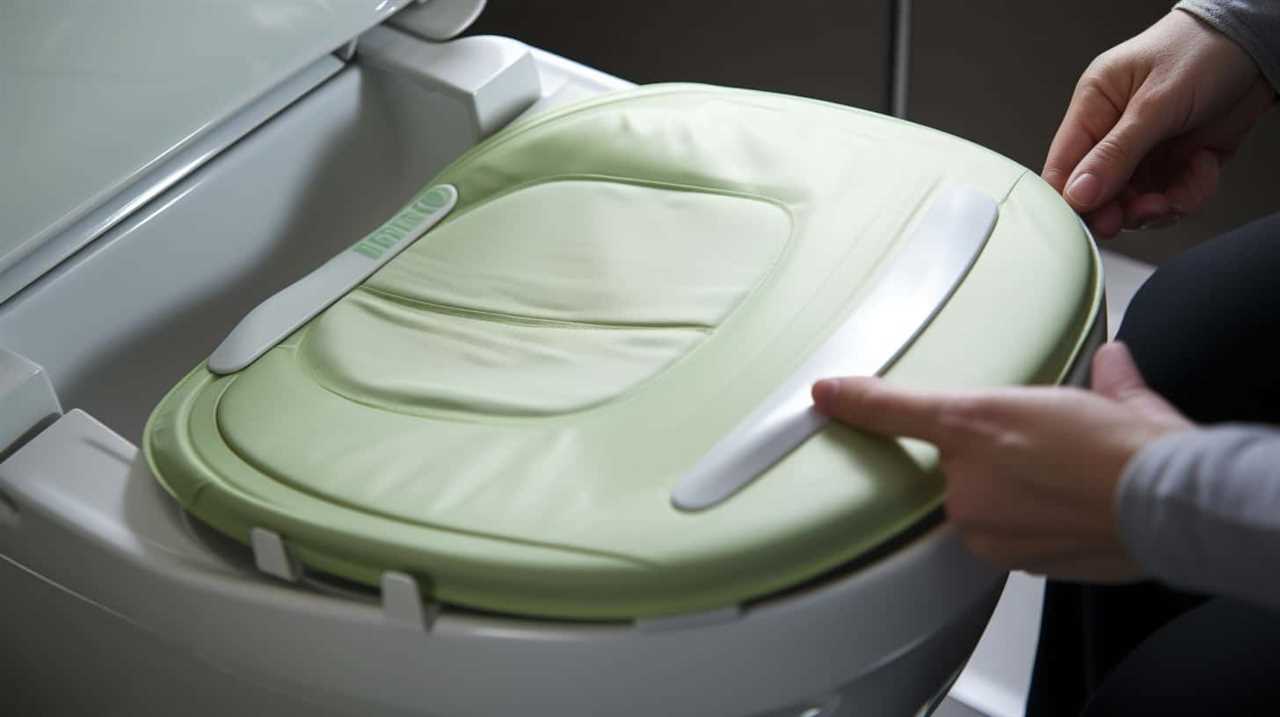
Key Takeaways
- Italian plumbing systems are designed to handle the disposal of toilet paper without any issues.
- In many parts of Italy, the plumbing systems aren’t designed to handle toilet paper, so it is not flushed.
- Italians often dispose of used toilet paper in a waste bin next to the toilet instead of flushing it.
- Proper toilet paper disposal in Italy contributes to the preservation of the country’s historic buildings and protects the delicate plumbing infrastructure.
Plumbing System in Italy
In Italy, the plumbing system allows us to flush toilet paper down the toilet. This convenience isn’t only practical but also has important maintenance and environmental implications.
When it comes to maintenance, Italian plumbing systems are designed to handle the disposal of toilet paper without any issues. The pipes and sewer systems are built to efficiently transport and process waste, including toilet paper, preventing clogs and blockages. This is a testament to the advanced engineering and infrastructure in the country.
From an environmental perspective, allowing the flushing of toilet paper reduces the need for alternative disposal methods such as trash bins or separate waste systems. It also minimizes the risk of contamination and the spread of bacteria.
However, cultural differences in toilet paper disposal exist, which we’ll explore in the next section.

ARTICLE TRANSITION:
Now that we’ve discussed the plumbing system in Italy, let’s delve into the cultural differences in toilet paper disposal.
Cultural Differences in Toilet Paper Disposal
Let’s explore the cultural differences that exist when it comes to disposing of toilet paper in Italy. Toilet paper etiquette in Italy is quite different from what most of us are accustomed to.
- Do Not Flush: In many parts of Italy, the plumbing systems aren’t designed to handle toilet paper. Instead of flushing it down the toilet, Italians often dispose of used toilet paper in a waste bin next to the toilet.
- Bin Placement: It’s important to note that these waste bins are usually lined with plastic bags, which are replaced regularly to maintain cleanliness.
- Odor Control: To minimize any unpleasant smells, it’s common for Italians to use scented garbage bags and air fresheners in the bathroom.
Understanding these cultural differences in toilet paper disposal is crucial to avoid any plumbing mishaps during your visit to Italy.
Now, let’s explore some alternative methods of toilet paper disposal.

Alternative Methods of Toilet Paper Disposal
We can explore some alternative methods of toilet paper disposal in Italy. While flushing toilet paper is not the norm, there are sustainable options available. One popular method is using a bidet, which is a separate water basin used for cleaning oneself after using the toilet. Bidets are commonly found in Italian bathrooms and offer a hygienic and eco-friendly alternative to toilet paper. Another option is to use toilet paper specifically designed for disposal in waste bins, rather than flushing it. These specially-made toilet paper products are biodegradable and can be safely discarded in the bins provided. By utilizing these alternative methods, Italians are able to reduce their environmental impact while maintaining cleanliness. Speaking of cleanliness, let’s now move on to some tips for using public restrooms in Italy.
| Sustainable Options | Bidet Usage |
|---|---|
| Hygienic | Water-based |
| Eco-friendly | Reduces waste |
| Common in Italy | Alternative to toilet paper |
| Biodegradable | Clean and refreshing |
| Reduces environmental impact | Promotes personal hygiene |
Now that we’ve explored alternative methods of toilet paper disposal, let’s dive into some tips for using public restrooms in Italy.
Tips for Using Public Restrooms in Italy
Moving on to using public restrooms in Italy, there are a few tips that can help ensure a pleasant experience.
- Practice good hand hygiene: Always carry hand sanitizer or antibacterial wipes, as not all restrooms may have soap or paper towels available.
- Follow proper toilet etiquette: Italians are serious about keeping restrooms clean. It’s important to remember to not throw toilet paper into the toilet bowl, but instead, dispose of it in the waste bin provided.
- Be prepared for paid restrooms: Many public restrooms in Italy require a small fee for usage. It’s helpful to always carry some loose change to avoid any awkward situations.
Conclusion: Proper Toilet Paper Disposal in Italy
Continuing the conversation from the previous subtopic, we can delve into the proper disposal of toilet paper in Italy. When it comes to cultural implications, it is important to note that Italy has a different approach to toilet paper disposal compared to other countries. In most regions, it is customary to throw used toilet paper into a bin next to the toilet instead of flushing it down the toilet. This practice is rooted in the country’s older plumbing systems, which are not designed to handle large amounts of toilet paper.

This method of disposal may seem unusual to visitors, but it is essential to respect and abide by local customs. It is also worth considering the environmental impact of flushing toilet paper. By disposing of it in a bin, Italy reduces the strain on its sewage system and prevents potential blockages and costly repairs. Additionally, this practice contributes to the preservation of the country’s historic buildings, as it helps protect the delicate plumbing infrastructure.
To help you understand the proper toilet paper disposal in Italy, here is a simple table outlining the key differences compared to other countries:
| Country | Toilet Paper Disposal Method |
|---|---|
| Italy | Throw in a bin |
| United States | Flush down the toilet |
| United Kingdom | Flush down the toilet |
Frequently Asked Questions
Is the Plumbing System in Italy Similar to the Plumbing System in Other Countries?
Cultural differences affect plumbing systems worldwide. When comparing the plumbing system in Italy to others, it’s essential to consider factors like toilet paper disposal. Understanding these variations helps us navigate plumbing practices while traveling.
What Are Some Cultural Differences in Toilet Paper Disposal in Italy Compared to Other Countries?
Cultural practices vary when it comes to toilet paper disposal in Italy compared to other countries. It’s important to note that some places don’t allow flushing due to the plumbing system and environmental impact.

Are There Any Alternative Methods of Toilet Paper Disposal Commonly Used in Italy?
There are alternative methods of toilet paper disposal commonly used in Italy. Some eco-friendly options include bidets, which provide a more thorough clean, and wet wipes, which can be tossed in a special bin.
Do Public Restrooms in Italy Have Any Specific Rules or Norms That Visitors Should Be Aware Of?
When using public restrooms in Italy, it’s important to be mindful of toilet paper etiquette and maintain cleanliness. Familiarizing yourself with the specific rules and norms will ensure a smooth experience.
Why Is Proper Toilet Paper Disposal Important in Italy?
Proper toilet paper disposal is important in Italy due to the environmental impact of improper disposal. It helps maintain hygiene and prevents clogging of the sewage system. It’s crucial to follow local guidelines and dispose of toilet paper in the appropriate bins provided.
Conclusion
In conclusion, when it comes to toilet paper disposal in Italy, remember to always follow their cultural norms and plumbing system. As the saying goes, ‘When in Rome, do as the Romans do.’

Be mindful of the alternative methods available and always use public restrooms responsibly. By respecting their customs, we can ensure a smooth and pleasant experience while visiting Italy.
So next time you’re in the beautiful country, remember to be considerate and flush the toilet paper in the designated manner.
With an impeccable eye for detail and a passion for bathroom-related, Ava leads our editorial team gracefully and precisely.
Under her guidance, Best Modern Toilet has flourished as the go-to resource for modern bathroom enthusiasts. In her free time, you might find Ava exploring antique shops and looking for vintage bathroom fixtures to add to her collection.
FAQ - Advanced Bathroom Queries
Can Wipes Go in the Toilet

Were you aware that flushing wipes down the toilet is the cause of over 90% of clogged pipes in the United States?
We, as a collective, need to understand the impact this seemingly harmless action has on our plumbing systems and the environment.
In this article, we will delve into the consequences of flushing wipes, explore alternative methods, and provide you with the proper disposal techniques.
Let’s educate ourselves and make informed decisions about the safety of flushing wipes.
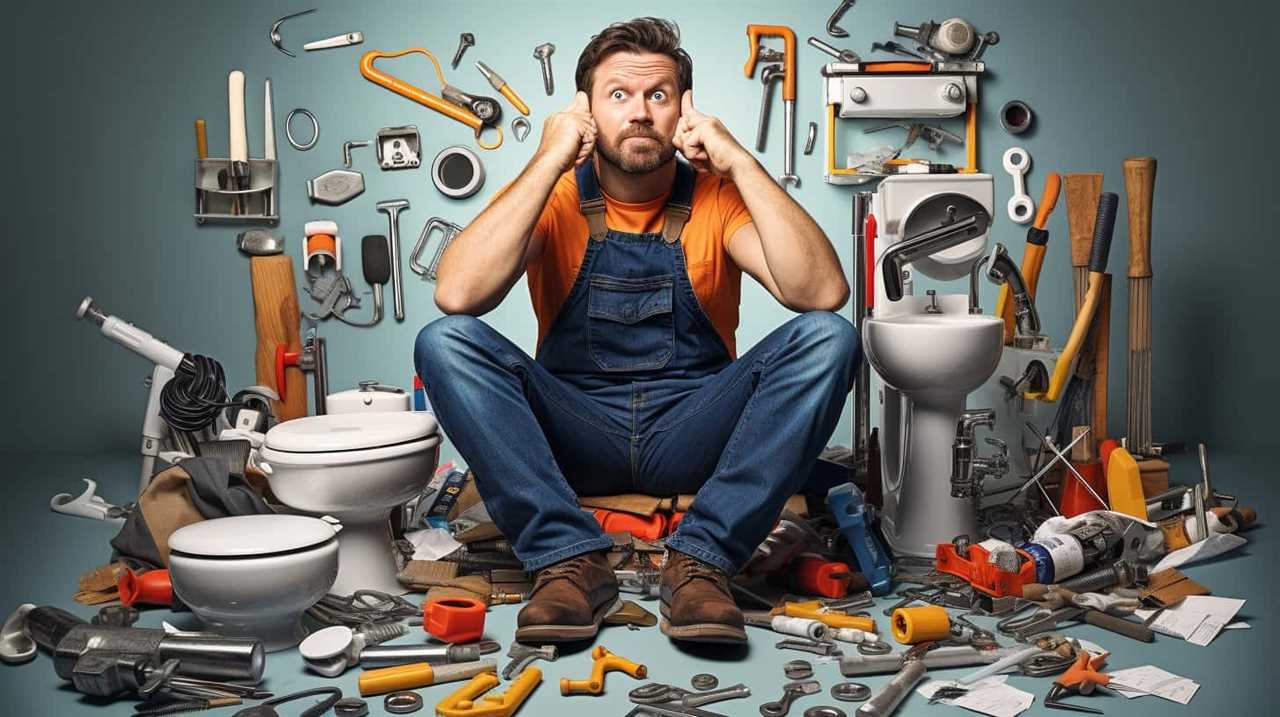
Key Takeaways
- Flushing wipes can cause clogged pipes, leading to expensive plumbing repairs.
- Flushing wipes contributes to marine pollution and harm to marine life and ecosystems.
- Biodegradable and reusable wipes are eco-friendly alternatives to flushing wipes.
- Proper disposal of wipes in the trash can help prevent blockages in the sewage system and protect the environment.
The Impact on Plumbing Systems
In our experience, flushing wipes down the toilet can have a detrimental impact on plumbing systems. When wipes are flushed, they can accumulate and create blockages in the pipes. This can lead to plumbing repairs that are time-consuming and costly.
The fibers in wipes don’t break down as easily as toilet paper, causing them to clump together and form clogs. These clogs can restrict the flow of water, leading to backups and potential flooding. Additionally, the presence of wipes in the pipes can create a breeding ground for bacteria, further exacerbating the problem.
It’s important to understand that the convenience of flushing wipes comes at the expense of potential plumbing issues. Transitioning to the subsequent section, the environmental consequences of flushing wipes will also be explored.
Environmental Consequences of Flushing Wipes
Continuing our exploration of the impact of flushing wipes on plumbing systems, we now turn our attention to the environmental consequences of this practice. Flushing wipes can have severe implications for our marine ecosystems and sewage treatment facilities.

Here are four key reasons why flushing wipes can be detrimental to the environment:
- Marine pollution: Wipes that are flushed down the toilet often end up in our oceans and waterways, contributing to marine pollution. These wipes can harm marine life, such as turtles and seabirds, when they mistake them for food or become entangled in them.
- Clogging sewage treatment facilities: Wipes don’t break down like toilet paper. Instead, they accumulate in sewage systems, leading to blockages and costly repairs for sewage treatment facilities. This can also result in untreated sewage overflow into our rivers and oceans.
- Increased energy and chemical usage: Dealing with wipes in sewage treatment plants requires additional energy and chemical usage, as these facilities need to work harder to break down and remove them. This increased resource consumption can have a negative impact on the environment.
- Microplastic pollution: Wipes often contain synthetic fibers that don’t biodegrade. When they enter water bodies, they break down into microplastics, which are harmful to aquatic life. These microplastics can be ingested by marine organisms, potentially entering the food chain and causing further harm.
It is crucial to avoid flushing wipes down the toilet to protect our marine ecosystems and sewage treatment facilities. Proper disposal in the trash can help mitigate these environmental consequences.
Alternatives to Flushing Wipes
Now, let’s delve into some alternatives to flushing wipes.
When it comes to biodegradable options, there are wipes available on the market that are made from materials that can break down naturally over time. These wipes are designed to be safe for the environment and can be disposed of in a compost bin or in the trash.

Another alternative is to create your own DIY reusable wipes. By using soft, washable materials such as cotton or bamboo fabric, you can make your own wipes that can be used multiple times before being washed. This not only reduces waste but also saves money in the long run.
Remember to wash these wipes thoroughly after each use to maintain hygiene.
Proper Disposal Methods for Wipes
To properly dispose of wipes, we should consider alternative methods that are safe for the environment and easy to implement. Here are four options to consider:
- Trash Bin: The simplest and most common method is to dispose of wipes in a trash bin. This ensures that they don’t end up in the sewage system and cause blockages.
- Composting: If you’re using biodegradable wipes, you can compost them along with other organic waste. Make sure to check the packaging for information on their biodegradability.
- Specialized Disposal Programs: Some municipalities offer specialized programs for disposing of wipes. These programs collect and dispose of wipes in an environmentally friendly manner.
- Flushable Wipes: If you choose to use flushable wipes, make sure they’re labeled as such and follow the manufacturer’s instructions. However, keep in mind that even flushable wipes can cause issues in the sewage system.
Considering the importance of hygiene practices during COVID-19, it’s crucial to dispose of wipes properly to protect the environment and prevent clogs in the sewage system.

However, is it really safe to flush wipes? Let’s find out in the next section.
Conclusion: Is It Safe to Flush Wipes?
After considering the various disposal methods for wipes, it’s important to assess the safety of flushing them down the toilet. Although convenient, flushing wipes carries certain risks that shouldn’t be overlooked.
One of the main concerns is the potential damage to septic tanks. Unlike toilet paper, wipes don’t break down easily. Instead, they can accumulate in the septic tank and clog the system. This can lead to costly repairs and even complete system failure.
Additionally, wipes may also contribute to sewer backups and overflow in municipal sewer systems, causing environmental contamination and health hazards.
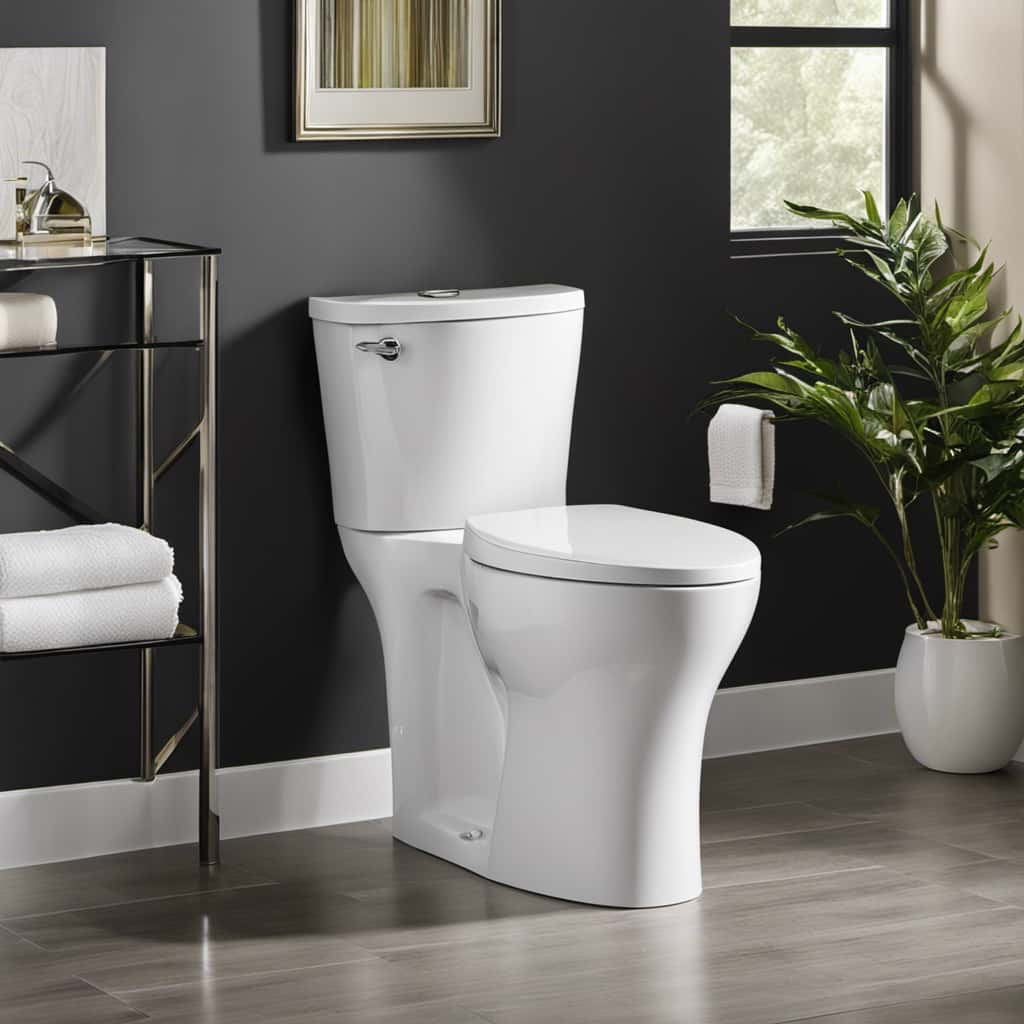
Therefore, it’s generally recommended to avoid flushing wipes and instead dispose of them in the trash to minimize the risks involved and prevent potential septic tank implications.
Frequently Asked Questions
How Do Wipes Affect the Quality of Water in Rivers and Oceans?
The impact of wipes on marine life is significant. Proper disposal methods are crucial to protect the quality of water in rivers and oceans. We must understand the consequences of not disposing of wipes correctly to ensure the health of our ecosystems.
Are All Types of Wipes Equally Harmful to the Environment When Flushed?
Different types of wipes have varying environmental impacts when flushed. Biodegradable wipes are more effective in reducing harm. Flushing wipes, regardless of type, can contribute to clogged pipes and sewage system issues.
Can Flushing Wipes Lead to Blockages in Household Plumbing Systems?
Flushing wipes can wreak havoc on our plumbing. We learned the hard way when our toilet backed up, causing a messy flood. Not only do wipes clog sewage systems, but they also pose potential health hazards.
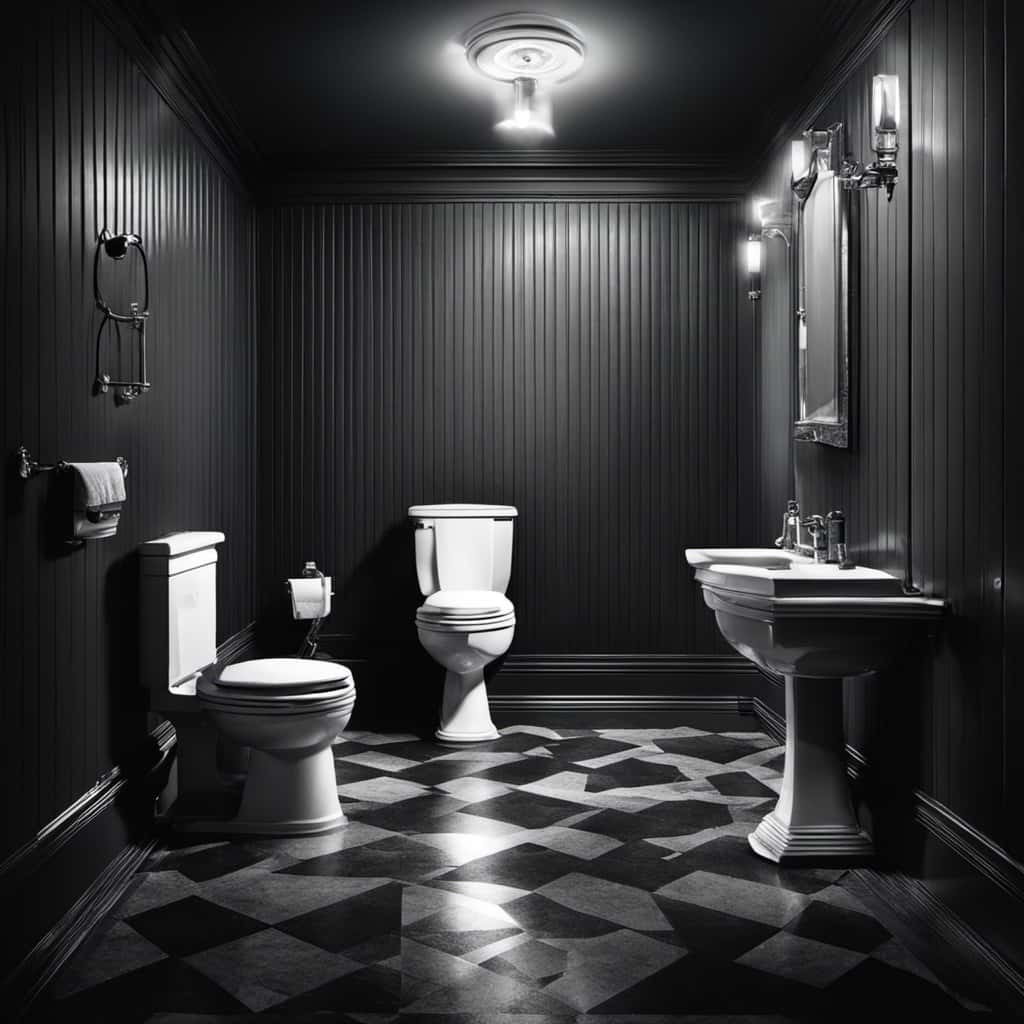
What Are Some Environmentally-Friendly Alternatives to Flushing Wipes?
Eco-friendly options and biodegradable alternatives are available as substitutes for flushing wipes. These alternatives are environmentally conscious and can help prevent blockages in household plumbing systems while still providing the desired functionality.
Are There Any Specific Guidelines for Disposing of Wipes in Landfills?
Guidelines for disposing of wipes in landfills are essential. We must follow proper procedures to avoid environmental harm. Disposing of wipes incorrectly can lead to clogged pipes, sewage backups, and negative impacts on our water systems.
Conclusion
In conclusion, it’s crucial to remember that wipes should never be flushed down the toilet. Despite their convenience, flushing wipes can lead to severe plumbing issues and have detrimental environmental consequences.
It’s essential to explore alternative disposal methods, such as throwing them in the trash or using biodegradable options.

Let’s be mindful of our actions and protect our plumbing systems and the environment for future generations.
With an impeccable eye for detail and a passion for bathroom-related, Ava leads our editorial team gracefully and precisely.
Under her guidance, Best Modern Toilet has flourished as the go-to resource for modern bathroom enthusiasts. In her free time, you might find Ava exploring antique shops and looking for vintage bathroom fixtures to add to her collection.
FAQ - Advanced Bathroom Queries
What Liquids Can Be Flushed Down the Toilet

Here’s what we’re aware of: not all liquids are safe to be flushed down the toilet. But don’t worry, we have the information on what can be safely flushed.
In this article, we’ll break it down for you, using our technical know-how and expertise. From water and urine to toilet paper and liquid waste from cleaning and personal care products, we’ll guide you through the dos and don’ts of flushing liquids.
Get ready to master the art of proper toilet liquid disposal!
Key Takeaways
- Water, urine, and toilet paper are the only liquids that can be safely flushed down the toilet.
- Flushing harmful liquids down the toilet can lead to water pollution, contamination of water sources, harm to aquatic life, and sewer system blockages.
- Liquids such as cooking oil and grease, medications and drugs, paint and solvents, and cleaning chemicals should never be flushed down the toilet.
- Proper disposal methods for liquids include utilizing recycling centers, contacting waste management authorities for guidance, participating in community collection events, and using sealed containers or absorbent materials before disposal.
Water
We can flush large quantities of water down the toilet without causing any harm to the plumbing system. Toilet water, which is essentially clean water, poses no threat to the pipes or the overall hygiene of the toilet. This is because the plumbing system is designed to handle the volume and flow of water during the flushing process.

Water is an essential element in maintaining toilet hygiene, as it helps in effectively rinsing away waste and preventing any unpleasant odors. Additionally, the force of the water during flushing aids in keeping the toilet bowl clean and free from any residue.
Therefore, when it comes to toilet hygiene, water is a safe and necessary liquid that can be flushed down the toilet without any concerns.
Urine
To maintain proper toilet hygiene, we can safely flush urine down the toilet. Urine is a waste product produced by the kidneys, consisting mainly of water and dissolved metabolic waste. It’s generally sterile and poses no significant risk to the environment or public health when flushed down the toilet. In fact, flushing urine helps to prevent odors and maintain a clean and hygienic toilet environment.
However, it’s important to note that if someone has a urinary tract infection (UTI), it’s advisable to seek medical attention and follow the prescribed treatment. UTIs can be caused by bacteria and flushing urine infected with bacteria may contribute to the spread of infection.
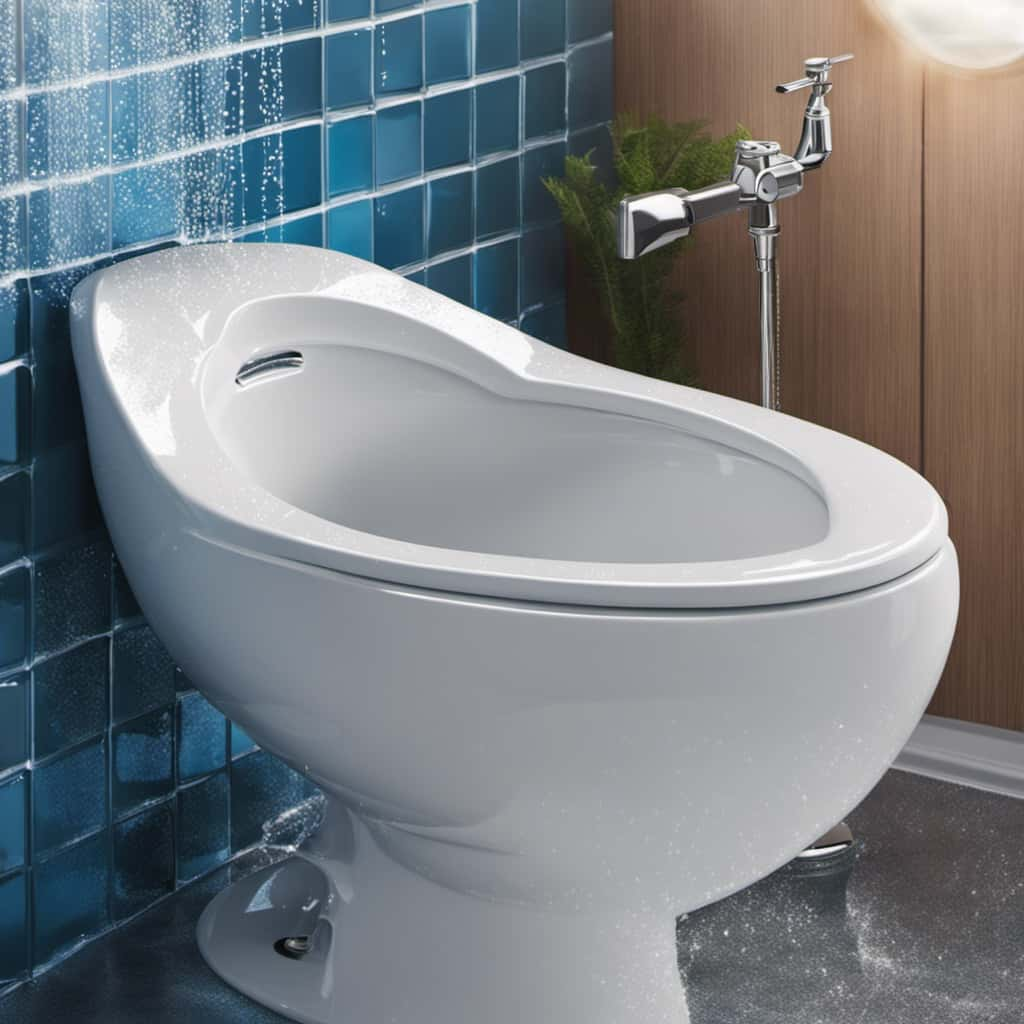
Now, let’s move on to the next essential topic of discussion: toilet paper.
Toilet Paper
Moving on from the previous subtopic of urine, let’s now discuss toilet paper and its role in maintaining proper toilet hygiene. Toilet paper is an essential item in every bathroom, and choosing the right brand is crucial. Here are four important factors to consider when selecting toilet paper:
- Softness: Look for brands that offer a soft and gentle texture to avoid any discomfort during use.
- Strength: Opt for toilet paper that’s strong and durable to prevent tearing or breakage.
- Absorbency: Consider brands that offer excellent absorbency for efficient cleaning and reduced usage.
- Eco-Friendliness: Explore toilet paper alternatives made from recycled materials or bamboo, which are more sustainable options.
Liquid Waste From Cleaning Products
After considering the factors for selecting the right toilet paper, let’s now turn our attention to the proper disposal of liquid waste from cleaning products. When it comes to liquid waste from cleaning products, it is important to be mindful of the impact on the environment. Many conventional cleaning products contain harmful chemicals that can pollute water systems and harm aquatic life. To minimize the negative effects, it is essential to explore eco-friendly alternatives and adopt proper disposal methods. Here is a table highlighting some eco-friendly alternatives and proper disposal methods for liquid waste from cleaning products:
| Eco-friendly Alternatives | Proper Disposal Methods |
|---|---|
| Use natural cleaning products made from plant-based ingredients | Dispose of liquid waste at designated collection points |
| Make your own cleaning solutions using vinegar, baking soda, and lemon juice | Avoid pouring cleaning product waste down the drain |
| Look for cleaning products with eco-label certifications | Follow local regulations for hazardous waste disposal |
| Use microfiber cloths and reusable mop pads instead of disposable wipes | Recycle empty cleaning product containers |
Liquid Waste From Personal Care Products
When it comes to liquid waste from personal care products, we must consider the proper disposal methods to minimize environmental impact. Here are four important points to keep in mind:
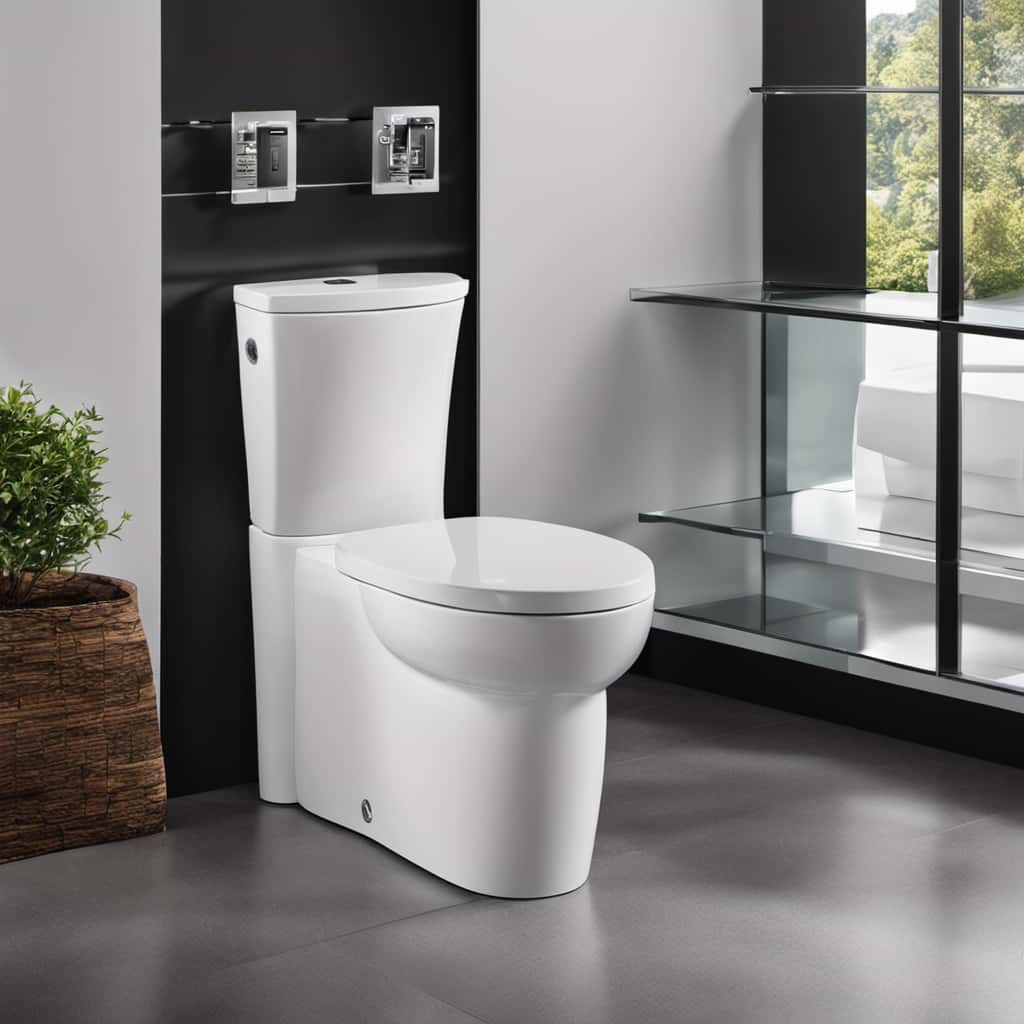
- Hazardous chemicals: Many personal care products contain hazardous chemicals such as parabens, phthalates, and triclosan. These substances can be harmful to aquatic life and may disrupt ecosystems if they enter water bodies.
- Environmental impact: Improper disposal of personal care product waste can result in contamination of water sources, affecting both human health and wildlife. It’s crucial to dispose of these liquids responsibly to minimize their impact on the environment.
- Proper disposal methods: Check local regulations for guidance on disposing of personal care product waste. In many cases, it’s best to minimize waste by using products sparingly and opting for environmentally friendly alternatives. When disposing of liquid waste, consider recycling options or take it to a designated hazardous waste collection facility.
- Consumer responsibility: As consumers, we’ve a role to play in minimizing the environmental impact of personal care products. Choosing products with eco-friendly formulations and packaging, as well as properly disposing of any liquid waste, can help protect the environment for future generations.
Frequently Asked Questions
Can I Flush Coffee Down the Toilet?
We can’t flush coffee down the toilet. It’s best to dispose of coffee grounds in alternative methods, like composting or throwing them in the trash. Flushing coffee can clog pipes and cause damage.
Is It Safe to Flush Expired Medication Down the Toilet?
Flushing expired medication down the toilet is not safe. It can have detrimental environmental impacts. Remember, "An ounce of prevention is worth a pound of cure." Properly dispose of medication through take-back programs or at designated collection sites.
Can I Dispose of Bleach by Flushing It Down the Toilet?
Flushing bleach down the toilet is not a safe way to dispose of it. The environmental impact of flushing bleach includes potential contamination of water sources and harm to aquatic life.
Is It Okay to Flush Cooking Oil or Grease Down the Toilet?
Flushing cooking oil or grease down the toilet is a big no-no. It can clog the pipes and cause serious plumbing issues. Proper grease disposal involves cooling, solidifying, and disposing of it in the trash.

Can I Flush Pet Waste, Such as Cat Litter, Down the Toilet?
When considering toilet safety precautions, it’s important to note that flushing cat litter down the toilet is not recommended. Cat litter can cause clogs and damage to plumbing systems. Dispose of it properly in the trash instead.
Conclusion
In conclusion, it’s important to only flush water, urine, toilet paper, and liquid waste from cleaning and personal care products down the toilet. Flushing other liquids can cause clogs and damage to the plumbing system.
Did you know that approximately 75% of plumbing issues are caused by improper flushing? Imagine the frustration of dealing with a clogged toilet and the costly repairs that can follow.
Let’s be mindful of what we flush to avoid unnecessary plumbing problems.
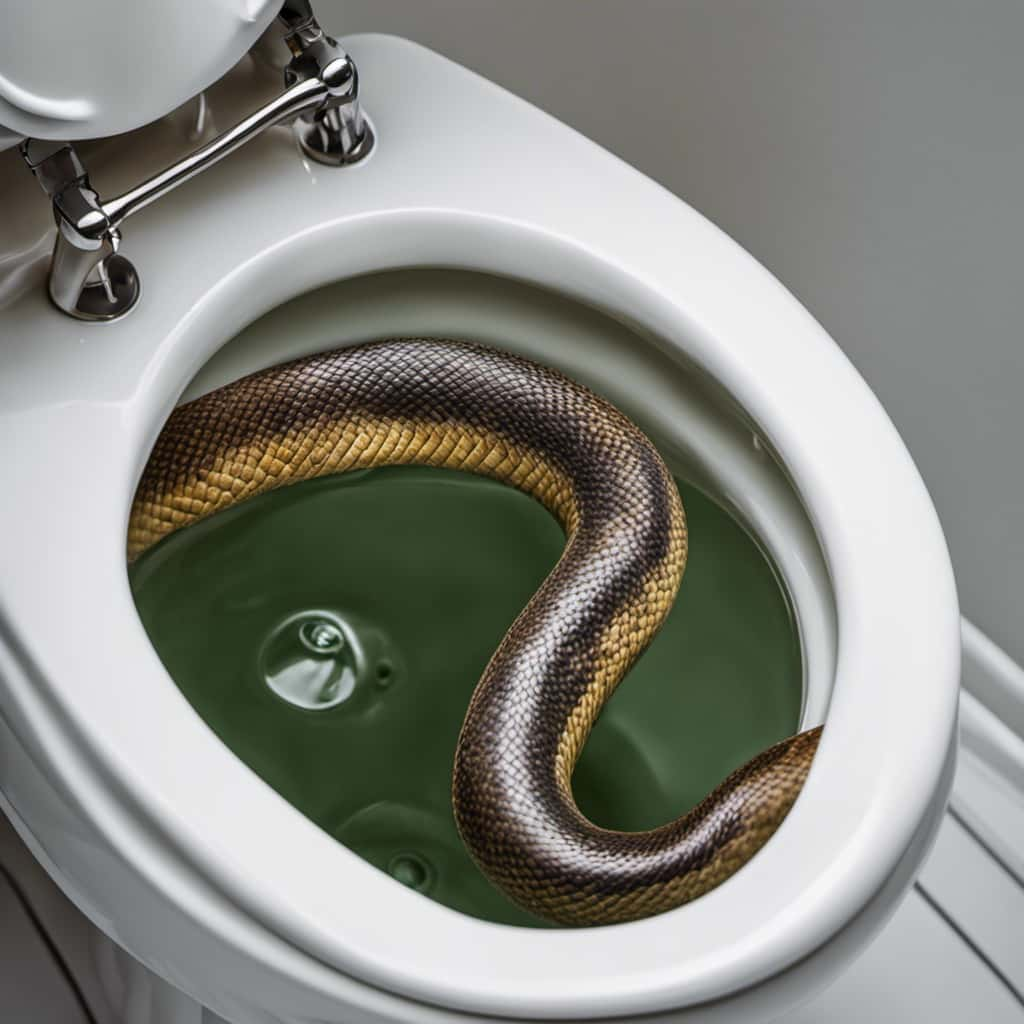
With an impeccable eye for detail and a passion for bathroom-related, Ava leads our editorial team gracefully and precisely.
Under her guidance, Best Modern Toilet has flourished as the go-to resource for modern bathroom enthusiasts. In her free time, you might find Ava exploring antique shops and looking for vintage bathroom fixtures to add to her collection.
-

 Reviews3 months ago
Reviews3 months agoLDian Smart Toilet Review [2024]
-

 Bathtub1 month ago
Bathtub1 month agoAre Clorox Toilet Wand Refills Septic Safe
-

 Reviews1 month ago
Reviews1 month agoLoupusuo Luxury Smart Toilet Review [2024]
-

 Reviews1 month ago
Reviews1 month agoSimple Project Modern Smart Toilet Review [2024]
-

 FAQ - Advanced Bathroom Queries3 weeks ago
FAQ - Advanced Bathroom Queries3 weeks agoWhat to Do if You Accidentally Flush a Paper Towel
-

 Toilet Brands1 month ago
Toilet Brands1 month agoCan You Put Toilet Paper Down the Toilet in Cyprus
-

 Reviews1 month ago
Reviews1 month agoLDian Smart Toilet Review: Luxury and Hygiene Combined [2024]
-

 FAQ - Advanced Bathroom Queries1 month ago
FAQ - Advanced Bathroom Queries1 month agoWhat to Do if a Toilet Paper Roll Gets Flushed Down the Toilet





















